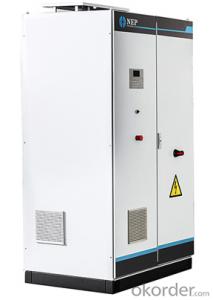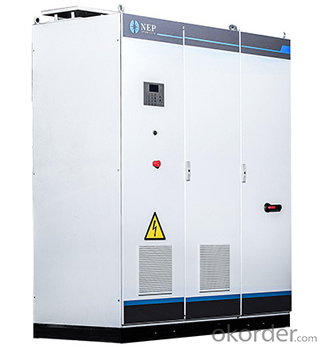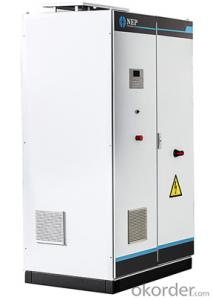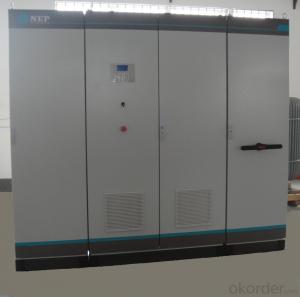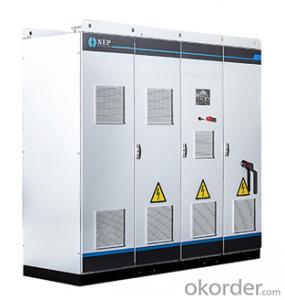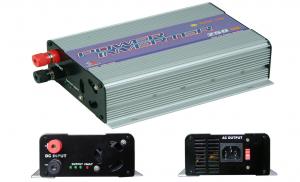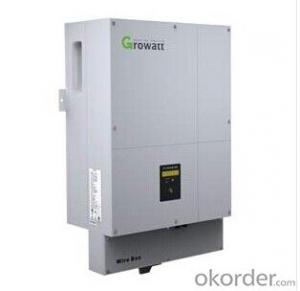Blue Solar Inverter Grid Tied Solar Inverter BDE-125K
- Loading Port:
- Qingdao
- Payment Terms:
- TT OR LC
- Min Order Qty:
- 10 unit
- Supply Capability:
- 1000 unit/month
OKorder Service Pledge
OKorder Financial Service
You Might Also Like
Description:
A solar micro-inverter, converts direct current (DC) electricity from a single solar panel to alternating current (AC). The electric power from several micro-inverters is combined and fed into an existing electrical grid. Micro-inverters contrast with conventional string or central inverter devices, which are connected to multiple solar panels.
Characteristic & Advantages:
More Energy Harvest: Distributed MPPT allows10~25% more energy harvest
Simple: Modularized,single ac cable to the house
Reliability: Longer life time and almost 100% operation hours
Security: No high Voltage, makes safter environments
Inteligent : Monitoring each module
Savings: No dc components and significantly save labor cost
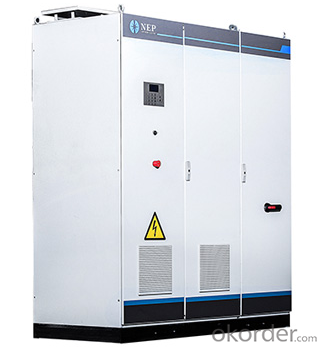
Datasheet:
BDE-125K | ||
(DC) | (kWp) | 137 |
(V) | 900 | |
(A) | 305 | |
MPPT | >99% | |
MPPT (V) | 450 - 820 | |
(AC) | (kW) | 125 |
(V) | 380 | |
(V) | 310-450 | |
(Hz) | 45.5—52.5 | |
THD | <3% ()< p=""> | |
| 0.92 () -- 0.92() | |
|
| 97.3%() |
| 96.9%() | |
(W) | <10< p=""> | |
|
| C (II) |
/ |
| |
/ |
| |
|
| |
|
| |
|
| |
|
| |
| IP20 | |
|
| -35℃ -- +50℃ |
| 0-95% RH | |
| 128*64 VFD | |
| RS485, RS232, , | |
(-- mm) | 800*1200*2200 | |
(kg) | 980 | |
- Q: Can a solar inverter be used in regions with high levels of lightning activity?
- Yes, a solar inverter can be used in regions with high levels of lightning activity. However, it is important to install appropriate lightning protection measures to ensure the safety and functionality of the solar inverter system. This can include surge protection devices and grounding systems to mitigate potential damage caused by lightning strikes.
- Q: What is the operating temperature range of a solar inverter?
- The operating temperature range of a solar inverter typically varies between -20°C to 60°C (-4°F to 140°F).
- Q: What is the role of a solar inverter in voltage and frequency regulation during islanding conditions?
- During islanding conditions, which occur when a distributed generation system (such as a solar PV system) continues to supply power to a local area even when the main electrical grid has been disconnected, the role of a solar inverter is crucial in maintaining voltage and frequency regulation. When a solar inverter operates in grid-connected mode, it synchronizes its output voltage and frequency with the utility grid. However, during islanding conditions, the solar inverter must transition into a standalone mode, where it becomes responsible for regulating voltage and frequency within the isolated microgrid. The primary function of a solar inverter in islanding conditions is to ensure that the voltage and frequency of the generated electricity remain within acceptable limits. It does this by constantly monitoring the electrical parameters and adjusting its own output accordingly. To regulate voltage, the solar inverter adjusts its output voltage based on the demand and the available power from the solar panels. It maintains a steady voltage level within a specified range, typically around 230-240 volts for residential applications. Frequency regulation is equally important, as it ensures that the electrical devices connected to the microgrid operate at their designed frequency, typically 50 or 60 Hz. The solar inverter continuously monitors the frequency and adjusts its output to match the required frequency, minimizing fluctuations and maintaining stability. In addition to voltage and frequency regulation, a solar inverter also provides other important functions during islanding conditions. These include power quality control, protection against overvoltage and overcurrent, and safe disconnection in case of emergencies or grid restoration. Overall, the role of a solar inverter in voltage and frequency regulation during islanding conditions is critical to maintain a stable and reliable power supply within the isolated microgrid. It ensures that the electricity generated by the solar PV system remains within acceptable parameters, allowing the connected electrical devices to operate efficiently and safely.
- Q: What happens to excess solar energy generated by the inverter?
- Excess solar energy generated by the inverter can be stored in batteries for later use or exported to the power grid, depending on the setup.
- Q: How does a solar inverter handle variations in grid voltage?
- A solar inverter handles variations in grid voltage by continuously monitoring the voltage levels and adjusting its output accordingly. It has built-in voltage regulation and control mechanisms that help maintain a stable and consistent output voltage, even when there are fluctuations in the grid voltage. This ensures that the solar inverter can efficiently convert the DC power generated by the solar panels into AC power that is synchronized with the grid, regardless of any voltage variations in the grid.
- Q: Can a solar inverter be used in regions with high levels of dust or debris?
- Yes, a solar inverter can be used in regions with high levels of dust or debris. However, it is important to regularly clean and maintain the inverter to ensure optimal performance and prevent any damage caused by the accumulation of dust or debris.
- Q: What is the role of a solar inverter in reactive power control?
- The role of a solar inverter in reactive power control is to regulate and maintain the power factor of the solar power system. It helps in balancing and adjusting the reactive power produced by the solar panels, ensuring that the system operates at an optimal power factor. This control is essential for efficient and stable operation of the solar power system, as it helps to minimize power losses and improves the overall performance of the system.
- Q: Is the PV inverter a current source or a voltage source?
- The inverter is mainly composed of a switching element such as a transistor, and turns the DC input into an AC output by repeatedly turning ON-OFF the switching element in a regular manner.
- Q: Can a solar inverter be used in areas with unstable grid power?
- Yes, a solar inverter can be used in areas with unstable grid power. In fact, solar inverters are often used in such areas to provide a stable and reliable power supply. The inverter's ability to convert solar energy into usable electricity allows it to function independently of the grid power, ensuring a continuous power supply even during grid outages or fluctuations.
- Q: How does the size of a solar inverter affect its performance?
- The size of a solar inverter directly impacts its performance. A larger inverter with a higher wattage capacity can handle a greater amount of solar power generated by the panels. On the other hand, a smaller inverter may not be able to efficiently convert and utilize all the energy produced, resulting in a decrease in overall system performance. Therefore, choosing the appropriate size solar inverter is crucial to ensure optimal performance and maximize energy production.
Send your message to us
Blue Solar Inverter Grid Tied Solar Inverter BDE-125K
- Loading Port:
- Qingdao
- Payment Terms:
- TT OR LC
- Min Order Qty:
- 10 unit
- Supply Capability:
- 1000 unit/month
OKorder Service Pledge
OKorder Financial Service
Similar products
Hot products
Hot Searches
Related keywords
